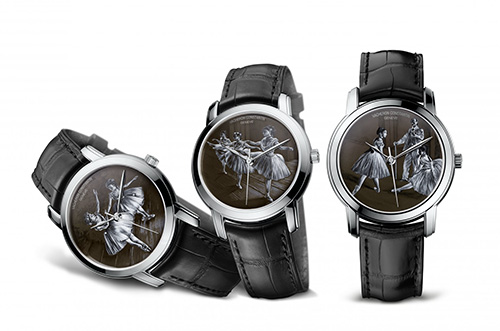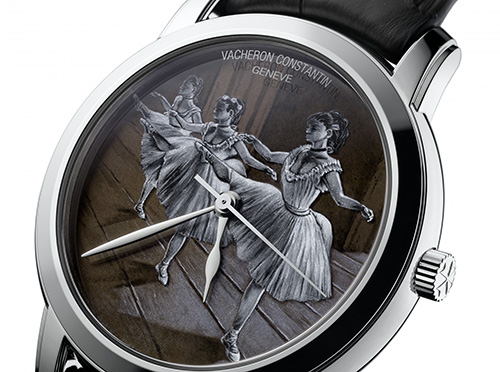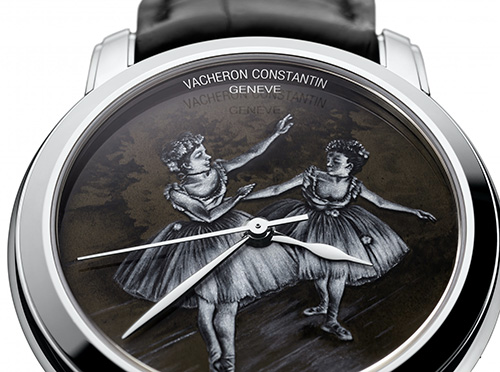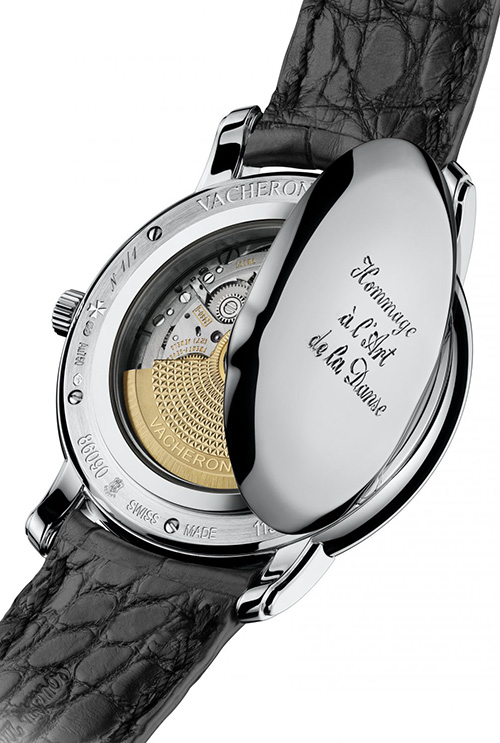2013/04/18
Vacheron Constantin the Métiers d’Art Hommage à l’Art de la Danse
A series of exceptional timepieces
unveiled on the occasion of the tricentenary of
the École Française de Danse
pays eloquent tribute to art and culture
- A new Métiers d’Art collection dedicated to the ancestral art of Grand Feu grisaille enamelling
- Three unique creations bearing the Poinçon de Genève (Hallmark of Geneva)
- A vibrant homage to the world of dance and the work of Edgar Degas, inspired by his fascination for ballerinas
On the occasion of the tricentenary of the École Française de Danse, Vacheron Constantin unveils the three first one-of-a-kind creations in its new Métiers d’Art Hommage à l’Art de la Danse collection. These creations from the workshops of the Manufacture revisit the ancestral art of Grand Feu grisaille enamelling to highlight the art of classical ballet through several masterpieces by Edgar Degas.
In becoming a patron of the Opéra National de Paris in 2007, Vacheron Constantin chose to provide a uniquely inspirational stage for the artisanal traditions of the Fine Watchmaking artistic crafts known in French as Métiers d’Art. This partnership uniting time, art and culture celebrates the values on which the brand has been built since its founding in 1755: supporting creativity, openness to the world, sharing a passion, passing on knowledge and the quest for excellence.
Ballet in particular and opera in general are worlds in which individuals, their talent and their personality set the crowning touch to the choreography of the work being performed. Vacheron Constantin shares with the Opéra National de Paris the art of precision, renewal and wonderment – an art of which the technical and aesthetic mastery is orchestrated by a wealth of men and women exercising numerous skills. In horology as in ballet, accomplishment is above all an intensely human story filled with encounters and with shared and perpetuated skills. Time has no hold on these crafts governed by high demands and constant challenges crystallised by perpetual enhancement, boldness and passion.
Following in the footsteps of the series inspired by the fresco painting by Marc Chagall adorning the ceiling of the Palais Garnier, Vacheron Constantin now provides a further demonstration of its expertise and its mastery of the most ancient decorative arts. The three first unique creations in the new Métiers d’Art Hommage à l’Art de la Danse collection will be presented at the gala evening for the tricentenary of the École Française de Danse, held on April 15th 2013 in the Palais Garnier. They reinterpret certain works by Edgar Degas – and his superlative ability to capture the graceful gestures and poses – through the age-old art of Grand Feu grisaille enamelling.
Métiers d’Art Hommage à l’Art de la Danse, capturing movement and the choreography of time
The three first Métiers d’Art Hommage à l’Art de la Danse watches crystallise the magic and the subtly alchemy between complementary arts: that of the ballerina, that of the enameller, and that of the watchmaker. These talents are portrayed through the subtly mastered shades of Grand Feu grisaille enamelling, a technique currently mastered by only a handful of artisans. Entirely crafted in the workshops of the Manufacture, the dials are a stunning expression of finesse and timeless elegance.
Within a white gold frame, Degas’ beloved ballerinas glide gracefully beneath the ever-dancing hands. The master enamel artist drew inspiration from three paintings: Ballet Room at the Opera in Rue le Peletier, 1874, oil on canvas on display at the Musée d’Orsay (Paris, France); Ballet Rehearsal, 1873, oil on canvas exhibited at the Fogg Art Museum (Cambridge, United States) ; and Two Dancers on Stage, 1874, oil on canvas on show at the Courtauld Gallery (London, United Kingdom). Chosen by the enameller after extensive research on the dancers’ expression, these paintings represent three key moments in the life of a ballerina: learning, practice and performance.
The finesse of Grand Feu grisaille enamel painting reveals the slightest details of the protagonists: the tiniest fold of the tutus, the lace adorning their décolleté, the smooth velvet of the ribbons encircling their neck, the petals of the flowers in their hair, the transparency of tulle and muslin… The dancers glide across a wooden parquet that reflects the light and reveals their shadows. Entirely in the manner of Degas, the Vacheron Constantin master enamel artist reinterprets the exact moment, the gestures, the pose and the perspective, playing on chiaroscuro light and shade effects to anchor the scene firmly in reality.
Whereas grisaille enamelling is generally applied to black enamel, the House artisan decided to work with a translucent brown enamel base serving to accentuate the depth effect while lending a soft nuance to the painting. After applying this base, the enameller adds touches of Limoges white enamel that is then drawn out out using needles, extremely fine brushes and even cactus thorns so as to create graded shades and play on the various pigments.
Limoges white enamel is a now rare and extremely rare powder mixed with oils. The challenge lies in the material itself that is extremely difficult to work with and requires the artisan to display almost intuitive sensitivity. Each of the layers requires a firing operation that must be timed to the nearest second. With each Grand Feu firing, the enamels change, become more intense and retract. The enameller’s experience plays an essential role in this process. The firing times are calculated according to the type and quantity of the material applied and their exact duration is one of the trade secrets of the artist who must juggle with a broad range of grey shades. The latter are perfectly suited to the art of portrait painting, as is confirmed by the extreme finesse shown in depicting facial expressions.
Framed to perfection by the understated elegance of a finely polished 40 mm-diameter case, the Grand Feu grisaille enamelling of the Métiers d’Art Hommage à l’Art de la Danse is entirely hand-crafted with infinite patience, meticulous care and intense concentration. A worthy heir to the spirit of the Cabinotiers cherished by the founders of the House, this ancestral technique reclaimed by Vacheron Constantin succeeds – without the help of vivid colours nor additional
material – in creating an authentic depth effect that captures the ballerinas’ experience right the way through to the tiniest fold in their costume. The music to which they move is the regular beat of the self-winding Calibre 2460, entirely developed and crafted in the Manufacture Vacheron Constantin. Such a work of art naturally deserved an exceptional movement, and its superlative finishes are performed in keeping with the finest Genevan traditions of Fine Watchmaking.
The Métiers d’Art Hommage à l’Art de la Danse meet the new standards of the Poinçon de Genève (Hallmark of Geneva). Instated by the Grand Council of the Republic and Canton of Geneva in 1886, the Hallmark is a guarantee of origin, of quality of workmanship, of durability and of expertise. This unrivalled quality label of independent origin underwent a fundamental transformation in 2011, as of when the certification no longer applies to the calibre alone, but to the watch as a whole. This represented a major evolution for this authentication that has enjoyed the longstanding support of Vacheron Constantin, which is more determined than ever to meet the true expectations of an ever more well-informed clientele.
History of grisaille enamelling
The first historical references to the grisaille enamelling technique are to be found between the 9th and the 12th centuries, and more specifically in a treatise by a monk named Theophilus dedicated to artistic techniques and entitled De Diversis Artibus. From the Middle Ages through to the 14th century, grisaille was interpreted in shades of brown – in fact a brownish red – through to black, according to the thickness involved. From the 15th century onwards, alongside rust, red and black grisaille enamels, others appeared that were called “sanguine on glass” and “wood colour” types of grisaille. They were made in workshops by glass painters and their formulae were passed down from generation to generation.
The École Française de Danse
On January 11th 1713, Louis XIV signed the decree instituting the first ballet school, thereby laying the foundations of the French choreographic style. An interest in establishing a dance technique already emerged in 1661 when the court ballet was at its peak. Based on the model of the national Academies of sculpture and painting, the King of France created the Académie Royale de Danse, thereby raising dance to the rank of an art while providing an official framework governed by the values of education and a determination to pass on knowledge. During this period, Pierre Beauchamp, Ballet Master at the Opéra, a brilliant dancer and director of the Académie de Danse as of 1680, steadily directed the institution’s activity towards a focus on teaching and established the rules of ballet, notably the one relating to the five positions. Louis XIV officially formalised the existence of the school in 1713.
The Opéra National de Paris and the École Française de Danse have been inseparably linked ever since, as if forming a single entity that has been writing the history of ballet for 300 years. The École Française de Danse is the world’s only company in which 95% of the dancers, soloists and Corps de Ballet were trained at the École de Danse de l’Opéra de Paris
Edgar Degas and ballerinas
In his work on ballerinas, Edgar Degas doubtless sought to explore the mystery of movement – seen as an expression of life itself. A painter born in 1834 and who died in 1917, Degas has often been classed as an impressionist. He nonetheless also took an interest in engraving and sculpture, worked with charcoal and pastels with which he mixed gouache and watercolours, created monotypes enhanced with chalk and lapis, as well as trying his hand at pictorialist photography using printing techniques based on oil-based pigments… A complete artist, he sought to capture light and movement in his works, using a wide variety of processes, cultivating his taste for technical experimentation and displaying a creative freedom that was extremely innovative for his era. Exactly like Vacheron Constantin and the Opéra de Paris, Degas constantly renewed his art.
His work, and particularly his series on ballet dancers, shows the extent of his mastery in summarising a sequence of movements, gestures and experiences. He uses elliptical shortcuts, close-ups, upward or downward-sloping perspectives, colliding oppositions and variations on the theme of paintings in contre-jour, or against the light. Edgar Degas invented a role for light-streaked floors in suggesting space – as magnificently illustrated on the dials of the Métiers d’Art Hommage à l’Art de la Danse. He carefully arranged the connections between reflections and sources of light, always closely attentive to the unexpected lighting of the ballet rail that projects colourful splashes onto the dancers’ faces. The artist dared to cut and segment so as to immortalise a moment of life encapsulated in a gesture, a posture, or a beam of light. In reference to his faithfulness to a number of classical rules, as well as to his many innovations, Jacques-Emile Blance wrote of his work in 1919 in these terms: “He bridged the gap between two eras; he linked the past to the most immediate present”.
The Métiers d’Art Hommage à l’Art de la Danse watches likewise create a link between yesterday and today. They unite art and individuals, expertise and creativity. Grand Feu grisaille enamelling reinterprets three works by the artist and embodies the ultimate concern for detail. Through its palette of shades ranging from brown to black, the technique also echoes the art of photography that so deeply fascinated Edgar Degas.





At the occasion of the 300th anniversary of L’Ecole Française de Danse (French Ballet School), Vacheron Constantin presents three unique pieces inspired by the work of French painter Edgar Degas.
Ref. :
- 86090/000G-9870 – The dance class
- 86090/000G-9880 – The rehearsal
- 86090/000G-9881 – Two dancers on stage
Hallmark of Geneva certified timepieces
- Caliber : 2460 SC, developed and crafted by Vacheron Constantin
- Energy : Mechanical hand-wound
- Movement diameter : 26.20 mm (11’’’ ¼ )
- Movement thickness : 3.60 mm
- Jewels : 27
- Number of components : 182
- Frequency : 4 Hz (28’800 vibrations/hour)
- Power reserve approx. : 40 hours
- Indications :
- Hours, minutes
- Center seconds
- Hours, minutes
- Case :
- 18 carats white gold
- 40 mm diameter, 9.20 mm thickness
- Officer and transparent caseback, closed by screws
- 18 carats white gold
- Water resistance : Tested at a pressure of 3 bar (approx 30 meters)
- Dial :
- 18 carats gold
- Grisaille and translucent Grand Feu enamelling
- Inspired by the work of French painter Edgar Degas
- 18 carats gold
- Strap : Black Mississippiensis alligator leather strap, hand-stitched, saddle-finish, large square scales
- Buckle :
- 18 carats white gold buckle
- Polished half Maltese cross
- 18 carats white gold buckle
- Unique pieces, only available in Vacheron Constantin Boutiques.

